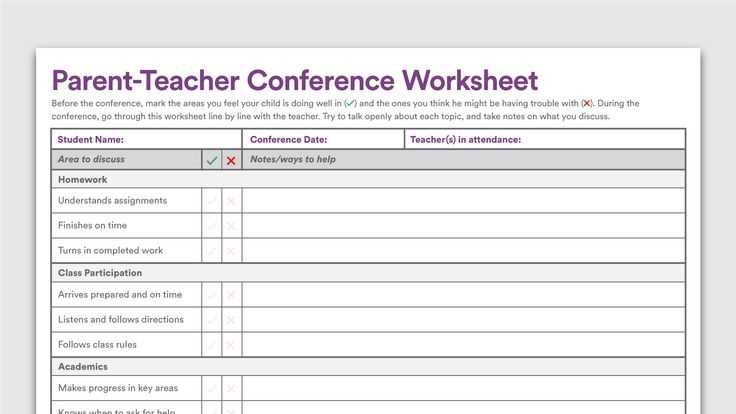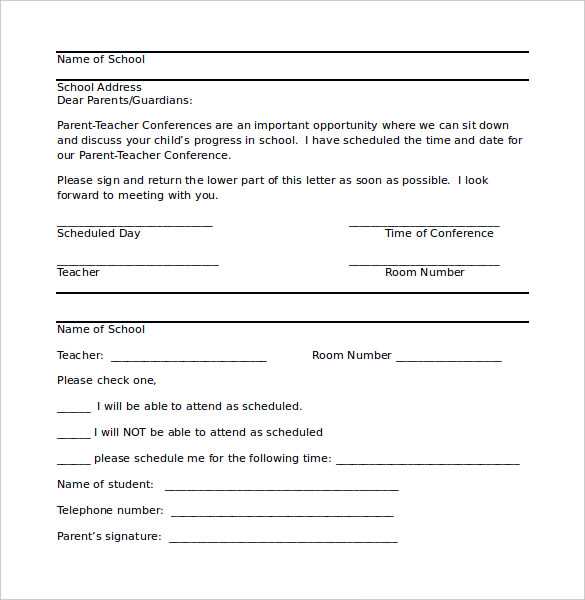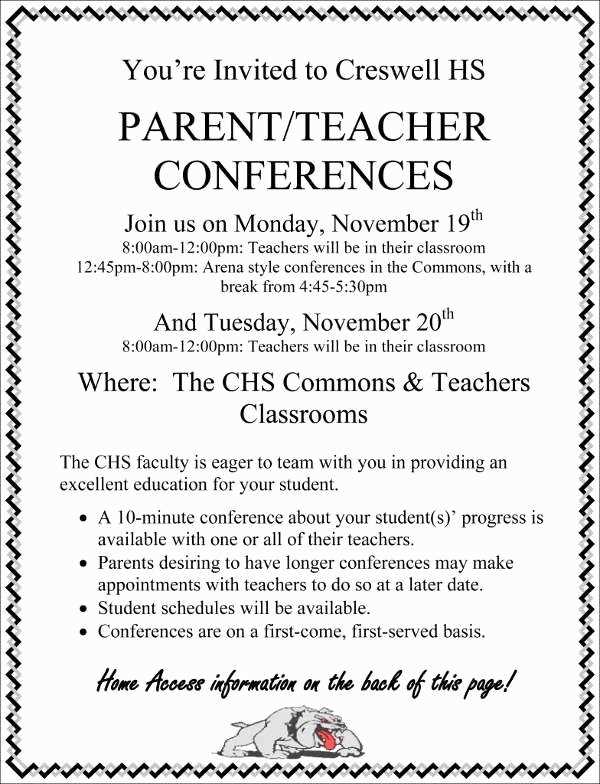Parent teacher conference letter template

Begin the letter by addressing the parent by name, acknowledging their child’s progress, and expressing your desire to discuss specific areas of their academic performance. For example, “Dear Mr. and Mrs. Smith, I am writing to invite you to a parent-teacher conference to discuss your child, Emma’s, progress in class.” This establishes a personal tone and immediately communicates the purpose of the meeting.
Next, include the details of the meeting. Clearly state the date, time, and location of the conference. If you’re offering multiple time slots, present them in a straightforward way to accommodate different schedules. For example, “The conference will take place on Wednesday, March 5th, between 3:00 PM and 5:00 PM. Please let me know which time works best for you.” This helps parents plan ahead and ensures that the meeting is scheduled efficiently.
Then, mention any specific topics or concerns that will be addressed during the meeting. Be specific, yet brief, focusing on the most pressing issues regarding the student’s academic performance, behavior, or any other notable areas. “We will review Emma’s progress in reading and discuss strategies to support her continued growth in this area.” This provides parents with a clear understanding of the meeting’s focus.
End the letter by inviting the parents to reach out if they have any questions or if they need to reschedule. Offering an open line of communication builds trust and ensures the meeting is productive. For instance, “If you have any questions before the meeting or need to adjust the time, please don’t hesitate to contact me.” Close with a friendly yet professional tone, such as, “I look forward to meeting with you and working together to support Emma’s success.”
Parent Teacher Conference Letter Template

When crafting a letter for a parent-teacher conference, it’s important to maintain clarity, warmth, and professionalism. Be specific about the student’s progress and areas that need attention. Here’s how to structure the message:
- Begin with a clear greeting: Address the parents by name. This sets a respectful tone from the start.
- Highlight key strengths: Focus on the student’s accomplishments and positive traits. For example, “Your child excels in participating during class discussions.”
- Discuss areas for improvement: Provide specific examples. For instance, “The student has struggled with completing homework on time” or “There is room for growth in reading comprehension.”
- Provide actionable suggestions: Offer clear guidance on how both parents and teachers can support the student. “Regular study sessions at home” or “Encouraging daily reading will benefit your child.”
- Set expectations for the conference: Let parents know what will be discussed and any materials they should bring. This helps prepare them for a productive meeting.
- End with a positive note: Reassure the parents that the goal is to work together. “I look forward to discussing how we can continue to support your child’s success.”
Example closing:
“Thank you for your continued support. I’m excited to collaborate to ensure your child has the best possible learning experience. Please let me know if you have any questions or concerns before the meeting.”
Key Elements to Include in a Letter
Address the recipient by name and include a personalized greeting to set a positive tone. Acknowledge the student’s progress or behavior in class, whether positive or areas needing improvement. Be specific about examples, such as recent projects, assignments, or classroom participation. Offer a clear outline of the student’s strengths and areas where they could use support, keeping the language constructive and objective.
Include details about upcoming events, meetings, or plans related to the student’s academic progress. For instance, mention dates for follow-up meetings or opportunities for further discussion. Let parents know how they can reach out for additional concerns or questions. Keep the communication lines open and approachable to ensure both parties feel involved and informed.
End the letter on a hopeful note, expressing a willingness to work together to help the student succeed. Sign the letter with a professional but friendly closing, followed by your contact information for easy access.
How to Address Parents Professionally
Use a polite and respectful tone in all communication. Start with a formal greeting, such as “Dear Mr. and Mrs. [Last Name],” to set a professional tone. Avoid overly casual phrases, as these can undermine the seriousness of the discussion.
Be clear and concise in your messages. State the purpose of the communication upfront, whether it’s to discuss the child’s progress, concerns, or upcoming events. Parents appreciate directness and clarity without unnecessary elaboration.
When providing feedback, focus on specific examples and avoid generalizations. Instead of saying, “Your child is struggling,” mention the areas where improvement is needed, such as “Your child has shown difficulty in completing math assignments on time.” This approach helps parents understand the exact nature of the issue.
Express appreciation for parents’ involvement. Acknowledge their support and effort in their child’s education. This not only shows respect but also creates a collaborative atmosphere for resolving any concerns.
Maintain a positive, solution-focused tone, especially when addressing challenges. Offer practical suggestions or ways parents can help their child improve, such as encouraging a study routine or providing additional resources. Avoid blaming or sounding accusatory, as this can lead to defensiveness.
Conclude with a professional closing, like “Sincerely” or “Best regards,” followed by your full name and position. This final touch reinforces professionalism and leaves the door open for further communication.
Making the Tone Warm and Welcoming

Begin with a personal greeting that acknowledges the unique relationship between the teacher, the student, and the family. Use the student’s name early in the letter to make the communication feel individualized. Acknowledge the family’s commitment to their child’s education and express genuine interest in their well-being and progress.
Use Positive and Supportive Language
Choose words that convey positivity and encouragement. Highlight areas where the student excels, even if they are small achievements, and mention specific examples of growth. Reinforce that the conference is an opportunity to collaborate and ensure the student’s continued success.
Show Appreciation for the Family’s Involvement
Express gratitude for the parent’s time and involvement. Acknowledge the importance of their role in supporting their child’s learning. This helps create a sense of partnership and sets a collaborative tone for the upcoming discussion.
Structuring the Meeting Request Clearly
Begin with a straightforward and concise subject line that outlines the purpose of the request. Ensure it’s easy for the recipient to understand the main point without needing to open the email. For example, use clear phrases like “Request for Parent-Teacher Meeting” or “Scheduling a Discussion About [Child’s Name]’s Progress.”
In the body, express the purpose of the meeting briefly. Avoid unnecessary explanations or background information. Be direct and mention any specific areas you’d like to discuss, such as academic performance, behavior, or upcoming school events. This helps the recipient understand the agenda in advance.
Provide a selection of potential dates and times for the meeting. This allows the recipient to choose a convenient time, making it easier to coordinate. You can include a table with multiple options:
| Date | Time |
|---|---|
| Monday, February 5 | 10:00 AM – 12:00 PM |
| Tuesday, February 6 | 2:00 PM – 4:00 PM |
| Wednesday, February 7 | 9:00 AM – 11:00 AM |
Make sure to add your contact information for any clarifications. This shows that you’re accessible and willing to discuss the meeting details further. Finish by thanking the recipient for their time and attention.
How to Mention Student Performance and Behavior

Provide clear and specific examples of the student’s performance and behavior to give a full picture. Focus on actions and outcomes rather than general statements.
- Highlight areas where the student excels. For example, “John consistently participates in class discussions and demonstrates a strong understanding of the material.”
- Note any improvements. For example, “Over the past few weeks, Sarah has shown significant improvement in completing assignments on time.”
- Address any challenges calmly, focusing on solutions. “Mark tends to get distracted during group activities. Encouraging more structure may help him stay focused.”
- Offer specific feedback on behavior, such as, “Lucy is very respectful to her peers and often helps others with their work.”
By providing concrete examples and offering constructive feedback, you help parents understand both strengths and areas for growth in their child’s development.
Including Contact Information and Next Steps

Ensure your letter includes clear contact details for follow-up. Provide both email and phone number so parents can reach out easily. Mention specific office hours or times you are available for additional discussions. Be transparent about the best methods for reaching you, whether by phone or through a scheduled appointment.
Outline the Follow-Up Process
Clearly state any actions that need to be taken following the conference. If a follow-up meeting is necessary, specify the preferred timing and how it should be arranged. If there are forms or documents parents need to review, mention how and when they will be provided. Set expectations for any additional communications, such as progress reports or updates.